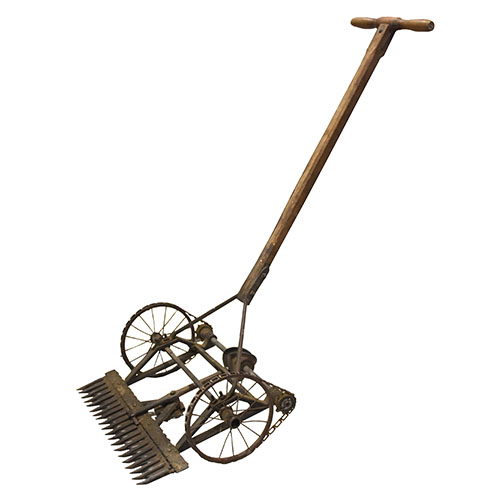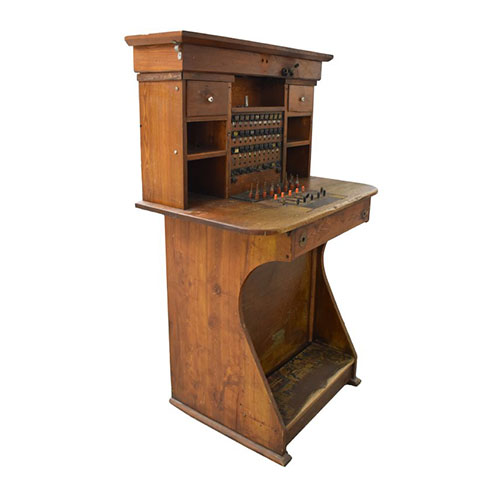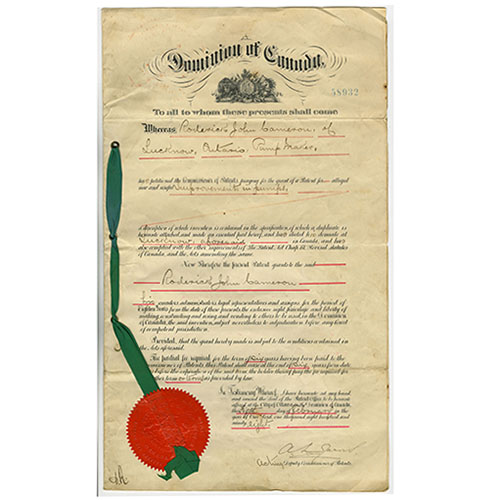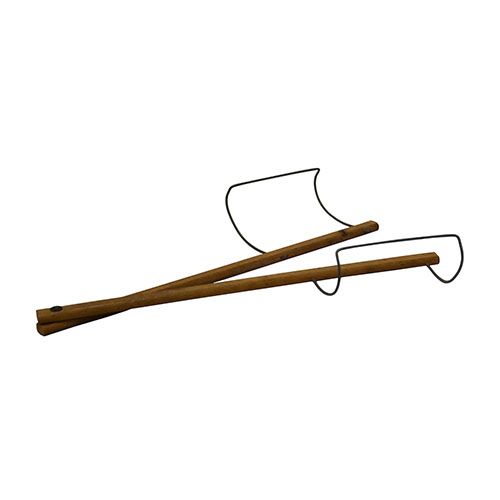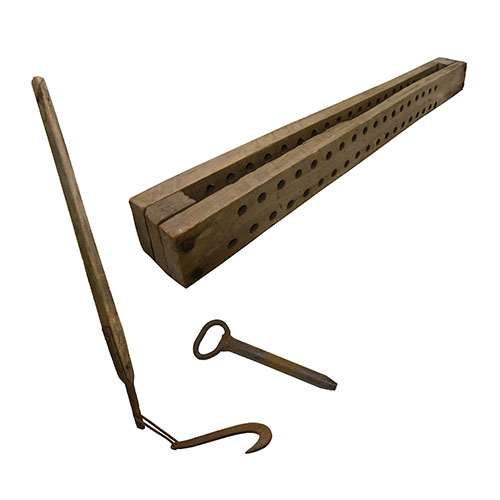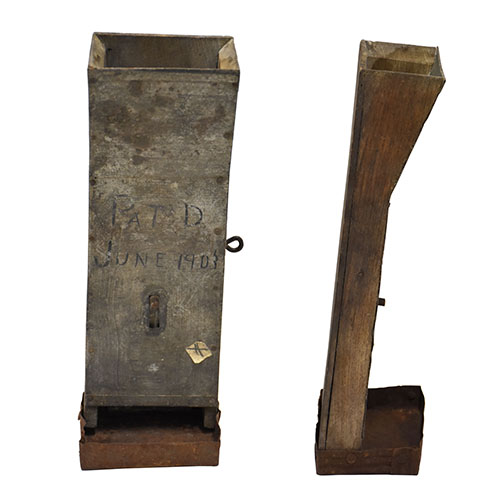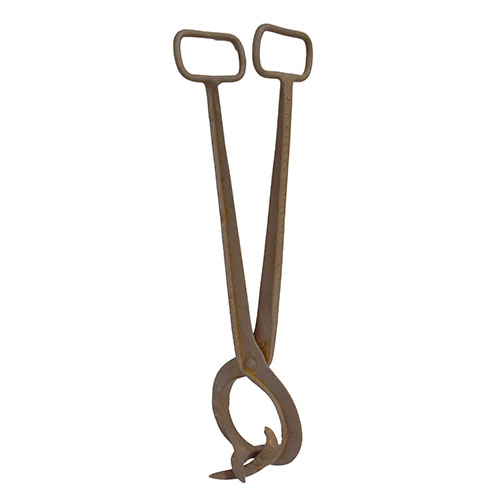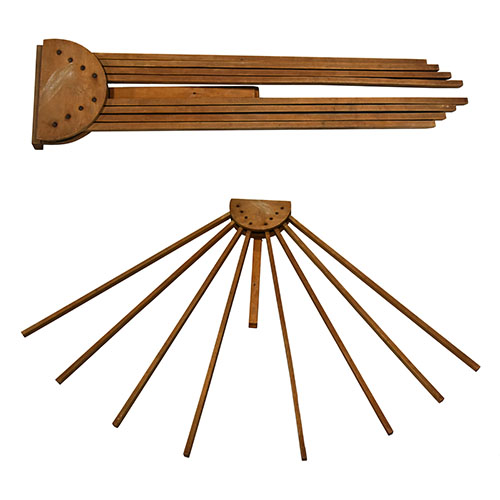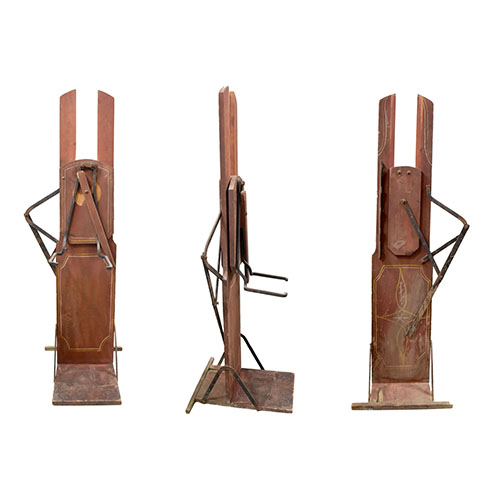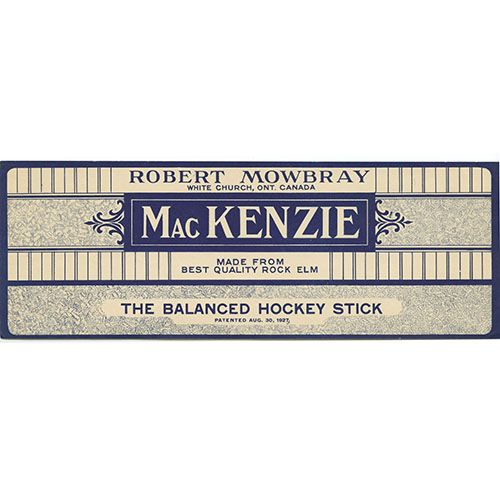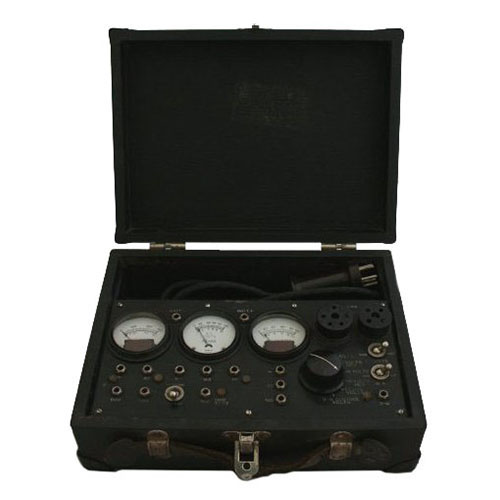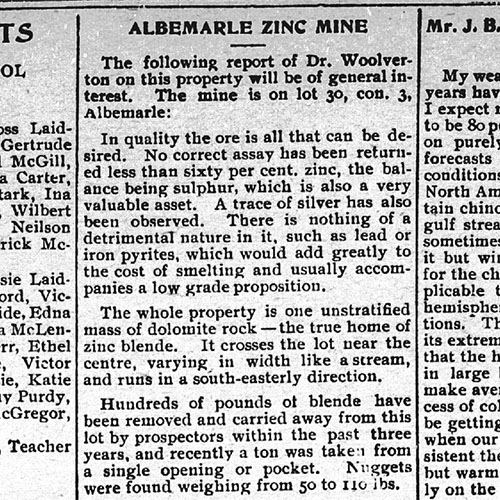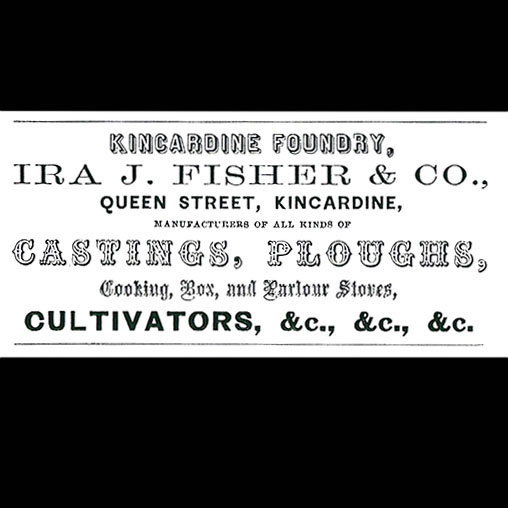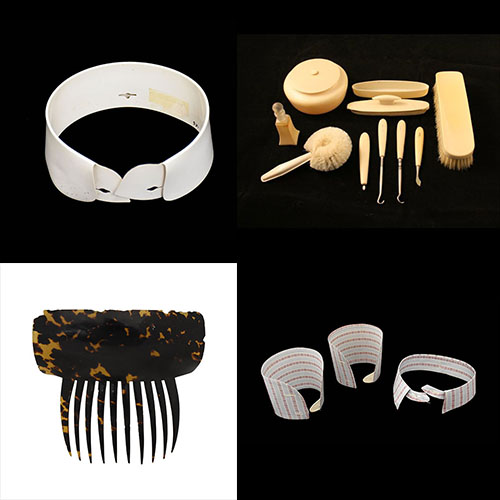Bruce County has always been full of innovative individuals, and patent agents were in the area early on. By 1869, two patent right agents, John McCosh and John Peterbaugh, had set up offices in Kincardine. Some individuals created items, such as stump pullers, out of necessity, and never decided to patent their creations. They were a means to an end. Others created improvements for things they saw as part of their occupation. For example, Alexander Luttrell of Kincardine, a baker, patented “Improvements on Egg Beaters” in 1881, and John Boyd of Lucknow, an artificial limb manufacturer, patented an adjustable leg splint to accommodate different sizes of legs in 1898. Others were innovative with things that affected their daily lives such as John W. McDonald of Paisley, a tinsmith, who created a new stove pipe damper and ventilator in 1886, or Louis Sees, of Port Elgin, who patented a fire escape in 1885.
Innovation and patents were not exclusive to men. Bruce’s women were also innovators and several patents issued to women can be found. Ladies were improving upon things that affected their daily lives. Annie Hawke of Tara created and patented a portable ironing table in 1890, featuring different leaves that allowed the board to change shape to match a garment, and fold away when not in use. Women also created items to resolve issues or improve their occupations such as Helen Braid Leadbetter of Kincardine, a schoolteacher, who patented a “Supplemental Stopper for Ink Bottles” in 1895 that went on top of an ink bottle and, if tipped, prevented the ink from spilling and also acted as a wiper when a pen nib was dipped in. Florence Piche Foster of Wiarton created a music teaching apparatus in 1907 to improve her ability to perform in her occupation.
Here are some innovative individuals represented within the collections and Archives.
Albert Strome
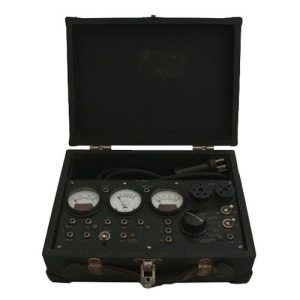 Albert Strome of Teeswater was a garage owner and machinist by trade. Wanting to have a “safe, efficient, and durable apparatus for measuring gasoline and delivering it to suitable receptacles,” Strome patented the inner workings of a gasoline pump in 1915 (Canadian Patent 168677). His design featured a fuel measuring mechanism located outside the dispensing tank. It also had a hose below the dispensing tank, rather than at the top. In this way, Strome’s design utilized gravity to dispense fuel through the hose rather than by further manual pumping (fuel had to be manually pumped from the main holding tank to the dispensing tank and then out). At the top of his drawings issued to the patent office, the pump is titled “Measuring & Dispensing Apparatus for Gasoline and the Like.” Though he didn’t invent the radio tube tester, Strome built this one himself and it was likely used in his shop.
Albert Strome of Teeswater was a garage owner and machinist by trade. Wanting to have a “safe, efficient, and durable apparatus for measuring gasoline and delivering it to suitable receptacles,” Strome patented the inner workings of a gasoline pump in 1915 (Canadian Patent 168677). His design featured a fuel measuring mechanism located outside the dispensing tank. It also had a hose below the dispensing tank, rather than at the top. In this way, Strome’s design utilized gravity to dispense fuel through the hose rather than by further manual pumping (fuel had to be manually pumped from the main holding tank to the dispensing tank and then out). At the top of his drawings issued to the patent office, the pump is titled “Measuring & Dispensing Apparatus for Gasoline and the Like.” Though he didn’t invent the radio tube tester, Strome built this one himself and it was likely used in his shop.
Donald MacKenzie
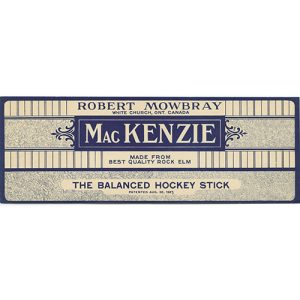 In 1926 Donald MacKenzie of Teeswater filed a patent (Canadian Patent 273438) for a hockey stick, which was granted in 1927. The stick was designed with a bend in the shaft, just below where the user would grip the stick. The object of the design was to “prevent the hockey stick from having so much tendency to turn in the hand of the player, thereby giving more control of the stick and more speed and efficiency in play.” Called the “MacKenzie” and marketed as the “Balanced Hockey Stick,” the sticks were manufactured by Robert Mowbray of Whitechurch, Ontario.
In 1926 Donald MacKenzie of Teeswater filed a patent (Canadian Patent 273438) for a hockey stick, which was granted in 1927. The stick was designed with a bend in the shaft, just below where the user would grip the stick. The object of the design was to “prevent the hockey stick from having so much tendency to turn in the hand of the player, thereby giving more control of the stick and more speed and efficiency in play.” Called the “MacKenzie” and marketed as the “Balanced Hockey Stick,” the sticks were manufactured by Robert Mowbray of Whitechurch, Ontario.
Frederick Cords
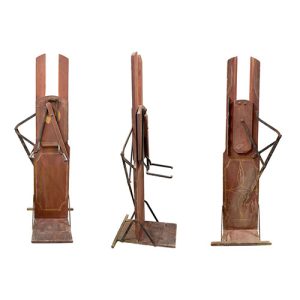 Fred Cords was raised in Brant Township in the vicinity of Elmwood. By 1921, he and his family had moved to Elmira where he was a farm labourer. He later became a fruit grower and farmer in Jordan Station. During his time in Bruce County, Fred was issued nine patents, either as a co-inventor, or by himself. His inventions included bag holders and trucks, a cattle guard, a gate, a clothes reel, a clothes dryer, and an ironing board. This bag holder, Canadian Patent 75323, was his first patent, issued in 1902. The objective of his invention was to provide “a simple, cheaply constructed, and easily operated device whereby bags of different sizes may be held while being filled and further make such device adjustable for holding bags of various lengths and also to be used conveniently by people of various heights.” The arms on this bag holder can be adjusted vertically to adjust for the height of the bag or the user, and the arms can be spread to hold a bag open. On the patent letter, Cords states he is living in Bentick Township, Grey County, but the machine itself boasts his name and Walkerton, which is where he likely had the device made. Later in 1910, he and George Redford patented another bag holder (Canadian Patent 126094). Again in 1912, Cords, along with Henry Horton Miller, he patented an improvement to his design of a bag holder and truck (Canadian Patent 139728).
Fred Cords was raised in Brant Township in the vicinity of Elmwood. By 1921, he and his family had moved to Elmira where he was a farm labourer. He later became a fruit grower and farmer in Jordan Station. During his time in Bruce County, Fred was issued nine patents, either as a co-inventor, or by himself. His inventions included bag holders and trucks, a cattle guard, a gate, a clothes reel, a clothes dryer, and an ironing board. This bag holder, Canadian Patent 75323, was his first patent, issued in 1902. The objective of his invention was to provide “a simple, cheaply constructed, and easily operated device whereby bags of different sizes may be held while being filled and further make such device adjustable for holding bags of various lengths and also to be used conveniently by people of various heights.” The arms on this bag holder can be adjusted vertically to adjust for the height of the bag or the user, and the arms can be spread to hold a bag open. On the patent letter, Cords states he is living in Bentick Township, Grey County, but the machine itself boasts his name and Walkerton, which is where he likely had the device made. Later in 1910, he and George Redford patented another bag holder (Canadian Patent 126094). Again in 1912, Cords, along with Henry Horton Miller, he patented an improvement to his design of a bag holder and truck (Canadian Patent 139728).
Harry Stevens
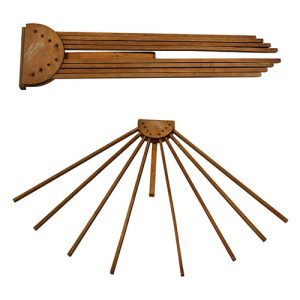 Harry was born at Gillies Hill in 1872, where his father William ran the store and post office. After 1891, he moved to Toronto, and by 1911, he had moved to Chesley and worked as a dry goods store clerk at C.J Halliday’s store. Shortly after 1911 Harry went to work for Great West Life Insurance as an agent and underwriter. In 1914 he patented a new design for an indoor clothes drying rack (Canadian Patent 158759). The objective of his design was to “provide improved means whereby the post supporting the clothes may be adjustable positioned within the guiding and supporting frame.” Another objective of the design was to “provide means of supporting the supporting arms, at the head of the post, so that the said arms and supporting means therefor may be folded down against the drier so that the drier may be compactly crated.” This piece of Stevens’ rack is the top section comprised of the head and drying arms.
Harry was born at Gillies Hill in 1872, where his father William ran the store and post office. After 1891, he moved to Toronto, and by 1911, he had moved to Chesley and worked as a dry goods store clerk at C.J Halliday’s store. Shortly after 1911 Harry went to work for Great West Life Insurance as an agent and underwriter. In 1914 he patented a new design for an indoor clothes drying rack (Canadian Patent 158759). The objective of his design was to “provide improved means whereby the post supporting the clothes may be adjustable positioned within the guiding and supporting frame.” Another objective of the design was to “provide means of supporting the supporting arms, at the head of the post, so that the said arms and supporting means therefor may be folded down against the drier so that the drier may be compactly crated.” This piece of Stevens’ rack is the top section comprised of the head and drying arms.
J.H. Jackson
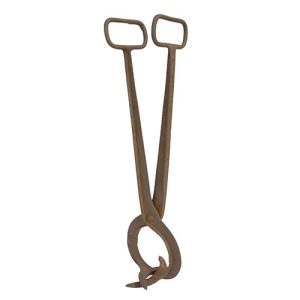 James Henry Jackson was born and raised in Sullivan Township, Grey County. By the turn of the century, he was a blacksmith in Keady, and by 1906 he was living in Saskatchewan. During his time in Grey County, he patented several things including a bob sled (Canadian Patent 41917), wagon (Canadian Patent 47492), bolster stake (Canadian Patent 52625), sleigh (Canadian Patent 64188), vehicle wheel (Canadian Patent 70203) and a root puller (Canadian Patent 84452). These root pullers have “J.H. Jackson Allenford Ont” forged into them, and they match the drawings in the patent schematics. The root pullers were designed to be used to harvest turnips, mangles, and other root vegetables, and the new part of the design is the concave nature of the “grappling jaws” which are meant to rest around the vegetable, while allowing the user to wrest it from the ground more easily. They would have been manufactured by Jackson while living briefly in Allenford between 1903 and 1906.
James Henry Jackson was born and raised in Sullivan Township, Grey County. By the turn of the century, he was a blacksmith in Keady, and by 1906 he was living in Saskatchewan. During his time in Grey County, he patented several things including a bob sled (Canadian Patent 41917), wagon (Canadian Patent 47492), bolster stake (Canadian Patent 52625), sleigh (Canadian Patent 64188), vehicle wheel (Canadian Patent 70203) and a root puller (Canadian Patent 84452). These root pullers have “J.H. Jackson Allenford Ont” forged into them, and they match the drawings in the patent schematics. The root pullers were designed to be used to harvest turnips, mangles, and other root vegetables, and the new part of the design is the concave nature of the “grappling jaws” which are meant to rest around the vegetable, while allowing the user to wrest it from the ground more easily. They would have been manufactured by Jackson while living briefly in Allenford between 1903 and 1906.
William John Washburn
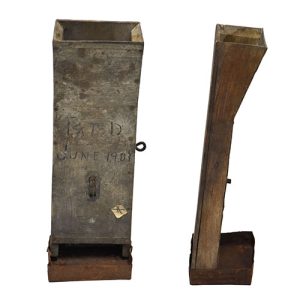 After his marriage in Brant Township, William Washburn settled in Chesley where he was a bricklayer. By 1911 he was a patent agent with an office in Chesley. Washburn wasn’t just an agent. He was an inventor himself and received three patents: a stove pipe fastener (Canadian Patent 36129) in 1891, a device for measuring oats (Canadian patent 81290) in 1903, and along with Charles Ewin Biehn, a clothes reel (Canadian patent 114935) in 1908. This device is a miniature version of Washburn’s oat measuring device which allows the user to “measure the quantity of oats fed to an animal so that there will be a minimum amount of waste thereof, and essentially consists of a receptacle, constructed of any suitable material, and of such size as to be conveniently placed within an ordinary manger feedbox.” Within there is a movable partition that would allow the user to measure out an amount of feed, turn the partition and let the oats fall into the bottom feed box.
After his marriage in Brant Township, William Washburn settled in Chesley where he was a bricklayer. By 1911 he was a patent agent with an office in Chesley. Washburn wasn’t just an agent. He was an inventor himself and received three patents: a stove pipe fastener (Canadian Patent 36129) in 1891, a device for measuring oats (Canadian patent 81290) in 1903, and along with Charles Ewin Biehn, a clothes reel (Canadian patent 114935) in 1908. This device is a miniature version of Washburn’s oat measuring device which allows the user to “measure the quantity of oats fed to an animal so that there will be a minimum amount of waste thereof, and essentially consists of a receptacle, constructed of any suitable material, and of such size as to be conveniently placed within an ordinary manger feedbox.” Within there is a movable partition that would allow the user to measure out an amount of feed, turn the partition and let the oats fall into the bottom feed box.
Reverend Robert George McKay
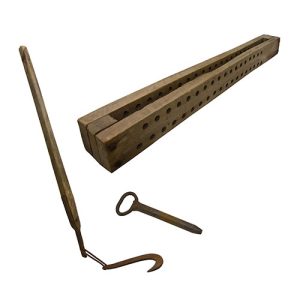 Revered Robert George McKay first came to Bruce in in 1925, where he was the Reverend of Walkerton Presbyterian Church until 1931. He returned to Bruce County in 1947 and was the Reverend of Tiverton Presbyterian Church 1952. During the 1920s Reverend McKay purchased property and built a cottage at Bruce Beach. According to family lore, Reverend McKay created this style of stump puller, which works by placing the hook around the stump and the long handle through the block, atop the iron pin. The handle can then be pulled down, acting like a lever and wrench the stump out. The further the stump is removed, the handle and pin can be moved up the holes or levels, until the stump is full removed from the ground. This stump remover design was never patented and was likely devised out of a need to clear his cottage lot, where the puller was stored for many years.
Revered Robert George McKay first came to Bruce in in 1925, where he was the Reverend of Walkerton Presbyterian Church until 1931. He returned to Bruce County in 1947 and was the Reverend of Tiverton Presbyterian Church 1952. During the 1920s Reverend McKay purchased property and built a cottage at Bruce Beach. According to family lore, Reverend McKay created this style of stump puller, which works by placing the hook around the stump and the long handle through the block, atop the iron pin. The handle can then be pulled down, acting like a lever and wrench the stump out. The further the stump is removed, the handle and pin can be moved up the holes or levels, until the stump is full removed from the ground. This stump remover design was never patented and was likely devised out of a need to clear his cottage lot, where the puller was stored for many years.
Royal Gawley
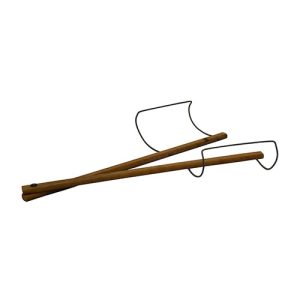 Royal Gawley, born in Hastings County, Ontario, was living in Bruce Township before 1870 and was a farmer there when he married Anna Maria Smith. By 1881, he and his family had moved to Elsinore where he was the general storekeeper. His wife died shortly after the birth of their son Chesley, and after Anna’s death (Feb. 6, 1888) Royal was suddenly stricken blind. To make a living, Royal made things for his neighbours such as wooden butter ladles and troughs, and pie lifters. The pie lifters are said to have been his own innovation (never patented), so women did not have to lean into the oven or use their aprons to remove warm pies. These he gave to neighbours who helped him or sold them for ten or fifteen cents.
Royal Gawley, born in Hastings County, Ontario, was living in Bruce Township before 1870 and was a farmer there when he married Anna Maria Smith. By 1881, he and his family had moved to Elsinore where he was the general storekeeper. His wife died shortly after the birth of their son Chesley, and after Anna’s death (Feb. 6, 1888) Royal was suddenly stricken blind. To make a living, Royal made things for his neighbours such as wooden butter ladles and troughs, and pie lifters. The pie lifters are said to have been his own innovation (never patented), so women did not have to lean into the oven or use their aprons to remove warm pies. These he gave to neighbours who helped him or sold them for ten or fifteen cents.
Roderick John Cameron
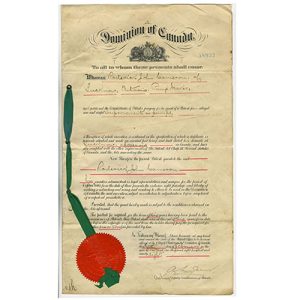 R.J. Cameron arrived in Lucknow and began working as a pump maker in the late 1890s. In February 1898, he received a patent for “Cameron’s Force, Lift & Spray Pump” (Canadian Patent 58932). In Cameron’s design water is “forced down through the cylinder and up through the pump rather than being drawn or sucked up through the cylinder and pump.” The objective of this design was that “the pump could be worked with much greater ease, will throw a better stream of water, will not freeze, will last longer, and will take water from a deeper well than other pumps.” The handle of Cameron’s pump was also in a different position designed to allow for greater leverage. The top of the pump was designed to no let air out so that it would force a more constant stream of water, and the design of having the check valve above the plunger rather than below it. Cameron continued to make pumps until between 1903 and 1910. This is the patent certificate issued to R. J. Cameron for his pump.
R.J. Cameron arrived in Lucknow and began working as a pump maker in the late 1890s. In February 1898, he received a patent for “Cameron’s Force, Lift & Spray Pump” (Canadian Patent 58932). In Cameron’s design water is “forced down through the cylinder and up through the pump rather than being drawn or sucked up through the cylinder and pump.” The objective of this design was that “the pump could be worked with much greater ease, will throw a better stream of water, will not freeze, will last longer, and will take water from a deeper well than other pumps.” The handle of Cameron’s pump was also in a different position designed to allow for greater leverage. The top of the pump was designed to no let air out so that it would force a more constant stream of water, and the design of having the check valve above the plunger rather than below it. Cameron continued to make pumps until between 1903 and 1910. This is the patent certificate issued to R. J. Cameron for his pump.
Elhanan Bowman
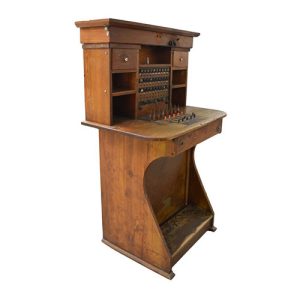 Elhanan Bowman was born in Woolwich Township, Ontario and moved with his family to farm in Saugeen Township by 1881. By 1901 he was living in Bentick Township, near Elmwood as a photographer. In 1904, he patented a train snowplough (Canadian patent 87516), which was designed to work on single or double tracks. Bowman later became an electrician and began working for the Elmwood Telephone Company. In 1912, he patented four devices for telephones (Canadian patents 139417, 141332, 141573, 145346). One device or apparatus was designed to give people the same privacy on a party line as a single line, and others were improvements to the telephone components for less wear and tear and ease of use. Bowman built the Elmwood Telephone exchange using parts from Northern Electric, and is the switchboard seen here.
Elhanan Bowman was born in Woolwich Township, Ontario and moved with his family to farm in Saugeen Township by 1881. By 1901 he was living in Bentick Township, near Elmwood as a photographer. In 1904, he patented a train snowplough (Canadian patent 87516), which was designed to work on single or double tracks. Bowman later became an electrician and began working for the Elmwood Telephone Company. In 1912, he patented four devices for telephones (Canadian patents 139417, 141332, 141573, 145346). One device or apparatus was designed to give people the same privacy on a party line as a single line, and others were improvements to the telephone components for less wear and tear and ease of use. Bowman built the Elmwood Telephone exchange using parts from Northern Electric, and is the switchboard seen here.
M.A. Halliday & Henry Hardcastle
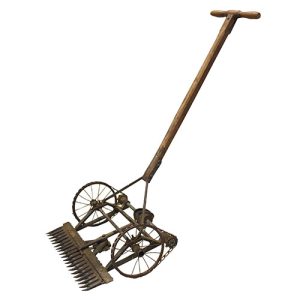 M.A. Halliday came to Chesley, prior to 1881, and became a merchant. He continued to operate the store until around the turn of the 20th century when he became a financial, insurance and loan agent. In 1901, along with Henry Hardcastle, a mechanic in Chesley, he patented a hay mowing machine (Canadian patent 73971). The mower was designed with two sets of knives moving in opposite parallel directions with the aim of reducing the jarring of the machines, reducing the need for heavy guards, and to create a lighter cutting bar.
M.A. Halliday came to Chesley, prior to 1881, and became a merchant. He continued to operate the store until around the turn of the 20th century when he became a financial, insurance and loan agent. In 1901, along with Henry Hardcastle, a mechanic in Chesley, he patented a hay mowing machine (Canadian patent 73971). The mower was designed with two sets of knives moving in opposite parallel directions with the aim of reducing the jarring of the machines, reducing the need for heavy guards, and to create a lighter cutting bar.
Henry Hardcastle was granted three other patents, including one for an ink stand, a stone picker, and a pulverizer attachment for land rollers (Canadian patents 59606, 66720, 56820). Records indicate that though he invented and patented the ink stand, Louis Robinson became the owner of the patent, suggesting that Hardcastle sold the patent rights to Robinson.
The lawn mower seen here is based on Halliday and Hardcastle’s mowing machine patent and was made by Batte of Walkerton.
Sources:
“Patent for improving pumps”, Patent (1898). A960.035.001
“Label for McKenzie hockey stick”, Label (1927-1939). A2007.005.001
Library & Archives Canada: https://www.bac-lac.gc.ca/eng/discover/patents-1869-1919/Pages/canadian-patents-1869-1919.aspx
Government of Canada: https://www.ic.gc.ca/opic-cipo/cpd/eng/search/basic.html?wt_src=cipo-patent-main
Bowman, Elhanan. Biography. Bruce County Museum & Cultural Centre Online Collection. https://brucemuseum.pastperfectonline.com/person/15109AD1-82E3-45E8-9AC1-203441385155
Cameron, Roderick John. Biography. Bruce County Museum & Cultural Centre Online Collection. https://brucemuseum.pastperfectonline.com/person/AE91C136-F9D8-4F49-87F9-281448323966
Cords, Frederick. Biography. Bruce County Museum & Cultural Centre Online Collection. https://brucemuseum.pastperfectonline.com/person/CEC40FC0-B91B-4DDD-85E1-615839083546
Gawley, Royal. Biography. Bruce County Museum & Cultural Centre Online Collection. https://brucemuseum.pastperfectonline.com/person/8840CA90-3211-4A39-9A89-987214330527
Halliday, M.A. (Matthew). Biography. Bruce County Museum & Cultural Centre Online Collection. https://brucemuseum.pastperfectonline.com/person/C3F3AC4A-3CD6-4A42-B8A7-698785754331
Jackson, James Henry. Biography. Bruce County Museum & Cultural Centre Online Collection. https://brucemuseum.pastperfectonline.com/person/1E7A5B2E-DD34-403E-9010-401382049665
MacKenzie, Donald. Biography. Bruce County Museum & Cultural Centre Online Collection. https://brucemuseum.pastperfectonline.com/person/0AE9B33F-EAF0-4CD3-9580-143945278549
McKay, Robert George (Rev.). Biography. Bruce County Museum & Cultural Centre Online Collection. https://brucemuseum.pastperfectonline.com/person/D91D4B7A-964C-4624-B960-945854313636
Stevens, Harry. Biography. Bruce County Museum & Cultural Centre Online Collection. https://brucemuseum.pastperfectonline.com/person/3D20AAD0-5B90-4C49-A104-766415651736
Strome, Albert. Biography. Bruce County Museum & Cultural Centre Online Collection. https://brucemuseum.pastperfectonline.com/person/CAFCED90-4BB0-466A-BA6F-986190026598
Washburn, William John. Biography. Bruce County Museum & Cultural Centre Online Collection. https://brucemuseum.pastperfectonline.com/person/162A3801-AA58-4C75-A900-441891964621

